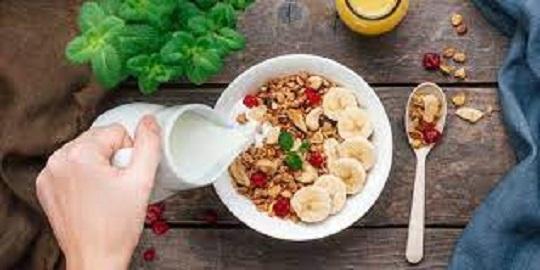Africa-Press – Lesotho. Healthy bodies come in all shapes and sizes. While weight loss is not a magic bullet for health, and not everyone needs to pursue weight loss, it might be something you want to work toward to feel your healthiest.
Coupled with regular movement, your diet can affect your health outcomes. (Just make sure to talk with a healthcare professional before making drastic changes!)
If losing weight is your goal, these 18 foods may help support a healthy weight loss journey, according to science. 1. Whole eggs Once feared for being high in cholesterol, whole eggs have been making a comeback.
These fears were rooted in misconceptions that overlooked how your body regulates cholesterol levels. Your body sources it, as needed, from your diet or your liver to maintain its baseline levels (1Trusted Source).
While people with elevated baseline levels of LDL (bad) cholesterol should be more conscious of how much cholesterol they get in their diet, moderate egg consumption — between 7–12 eggs a week — has been proven safe for many people (1Trusted Source, 2Trusted Source, 3Trusted Source, 4Trusted Source).
Although a higher intake of eggs may raise the levels of LDL cholesterol in some people, eggs are one of the best foods to eat if you’re looking to reach or maintain a healthier weight.
Eggs are incredibly nutrient-dense. Interestingly, almost all its nutrients are found in the yolks — like choline and vitamin D — though egg whites deliver 4–6 grams of protein each (5Trusted Source).
Because they’re high in protein and fat, they help you feel full (6Trusted Source, 7Trusted Source). That’s key, because responding to your body’s internal fullness and hunger cues can help you reach or maintain a healthy weight.
In other words, getting in the habit of eating when you’re hungry and stopping when you’re full can help your weight loss goals (8Trusted Source, 9Trusted Source). Want to feel full without going on a diet?
A study including 50 healthy people with more weight showed that eating eggs and buttered toast for breakfast — instead of cereal, milk, and orange juice — increased feelings of satiety (fullness) for the next 4 hours (10Trusted Source).
Similarly, another study among 48 healthy adults found that those who ate an egg-based breakfast, either high or moderate in both protein and fiber, reported higher satiety than those who ate low fiber cereal and milk (11Trusted Source).
Since feeling satiated can help combat overeating driven by feeling overly hungry, eating eggs may support your weight loss goals while also packing a ton of healthful nutrients into your day.
2. Leafy greens Leafy greens include kale, spinach, collard greens, Swiss chard, and a few others.
They have several properties that make them perfect for reaching or maintaining a healthy weight. For example, they pack fiber and nutrients that keep you satiated and hydrated.
What’s more, leafy greens contain thylakoids, plant compounds that have been linked with increased satiety and better appetite management in at least two human studies (12Trusted Source, 13Trusted Source, 14Trusted Source).
It’s worth noting, however, that both studies are small, and participants took a 5-gram thylakoid supplement — the amount found in about 3.5 ounces (100 grams) of raw spinach (13Trusted Source, 14Trusted Source).
Those receiving even a single dose of the supplement reported better appetite management, resulting in weight loss (13Trusted Source, 14Trusted Source).
However, more research in humans is needed to understand the effect of thylakoids from food sources as a tool for achieving a healthy weight — as well as their long-term effects in supplement form.
In the meantime, leafy greens boast an assortment of fiber and micronutrients and are almost always a great addition to your diet (15Trusted Source, 16Trusted Source).
Adding leafy greens to your diet can help you feel satiated and reduce cravings for less nutritious foods. Learning to respond to your body’s internal cues of hunger and fullness can aid your larger healthy weight loss goals (8Trusted Source, 9Trusted Source).
If you’re taking medications, such as blood thinners like warfarin (Coumadin), speak with a healthcare professional or a registered dietitian about how many leafy greens you should eat daily to find the right balance.
Leafy greens are high in vitamin K, which may interact with your medication. Consistent vitamin K intake is key (17Trusted Source). 3. Salmon Fatty fish like salmon are incredibly nutritious and very satisfying.
Salmon is loaded with high quality protein, healthy fats, and various important nutrients. That combination keeps you satiated and can help you reach a healthier weight (18Trusted Source).
Salmon is loaded with omega-3 fatty acids, which may help reduce inflammation. Inflammation plays a major role in obesity and metabolic disease (19Trusted Source, 20Trusted Source, 21Trusted Source).
What’s more, fish — and seafood, in general — may also supply a significant amount of iodine. The nutrient is necessary for proper thyroid function, which is important to keep your metabolism running optimally (22Trusted Source).
But studies show that a significant number of people don’t fill their iodine needs. Adding fatty fish to your diet can help you consume enough iodine (Trusted Source22Trusted Source).
Mackerel, trout, sardines, herring, tuna, and other types of fatty fish are also excellent for your health. 4. Cruciferous vegetables Cruciferous vegetables include broccoli, cauliflower, cabbage, and Brussels sprouts.
Like other vegetables, they’re high in fiber and tend to be incredibly filling. What’s more, these types of veggies contain decent amounts of protein.
They’re not nearly as high in protein as animal foods or legumes, but still high for vegetables (23Trusted Source, 24Trusted Source, 25Trusted Source, 26Trusted Source).
A combination of protein, fiber, and low energy density (low calorie content) makes cruciferous vegetables the perfect foods to include in your meals if you want to lose weight (27Trusted Source).
They’re also highly nutritious and contain compounds that may lower your risk of developing cancer. Keep in mind, though, that no amount of cruciferous vegetables can replace recommended cancer screenings or proper cancer treatment (28Trusted Source).
5. Chicken breast and some lean meats Meat remains a controversial food group for many people.
Beyond issues of sustainability and ethics, we’re still not sure whether and how red meat raises the risk of heart disease or diabetes. Research on meat consumption and health outcomes has yielded low evidence of causation.
That language can be confusing, and it’s often misinterpreted as a ringing endorsement to eat more meat, but it simply means that there isn’t enough evidence to say whether it causes unfavorable health outcomes (29Trusted Source, 30Trusted Source).
However, a high intake of red and processed meats is associated with a higher risk of cancer, diabetes, premature death, and heart disease (31Trusted Source). Eating unprocessed meat in moderation (i. e.
, 2–3 servings a week) alongside fruits, vegetables, and whole grains may mitigate some of the cancer risks associated with meat consumption (30Trusted Source).
Nutritionally, chicken and red meat are both high in protein and iron. Skinless chicken breast and lean red meat like tenderloin or flank steak pack protein and iron and have less saturated fat than other cuts.
Opt for these most of the time to better support weight management and heart health. Saturated fat has been thought to drive inflammation, which is associated with chronic illness.
However, research on this, too, has so far yielded mixed results (32Trusted Source, 33Trusted Source). How you prepare meat can also affect health outcomes.
Red meat that is cooked at high temperatures for a long duration, by smoking or grilling, for instance, renders fat drippings. Against hot cooking surfaces, these form a toxic by-product called polycyclic aromatic hydrocarbons (PAHs) that may cause cancer (34Trusted Source).
Minimize this risk by limiting smoke, wiping away drippings, and eating lean meat in moderation. This means no more than a few 3-ounce (85-gram) servings per week.
A serving is about the size of the palm of your hand (34Trusted Source). 6. Potatoes and other root vegetables White potatoes seem to have fallen out of favor — possibly, at least in part, due to the rise of lower carb diets.
For what it’s worth, potatoes and other root vegetables have several properties that make them wonderful foods for weight loss and optimal health. They contain an incredibly diverse range of nutrients — a little bit of almost everything you need.
They’re particularly high in potassium, a nutrient that most people don’t get enough of. Potassium plays an important role in blood pressure management (35Trusted Source).
On a scale called the Satiety Index, which measures how filling different foods are, boiled white potatoes scored the highest of all the foods tested (36Trusted Source).
What this means is that by eating boiled white or sweet potatoes, you’re more likely to naturally feel full. You’ll also be providing your body with essential nutrients.
If you allow potatoes to cool for a while after boiling, they will form high amounts of resistant starch, a fiber-like substance that has been shown to have various health benefits, including weight loss (37Trusted Source).
Sweet potatoes, turnips, and other root vegetables are also excellent choices. 7. Tuna Tuna is another satiating high protein food. It’s a lean fish, meaning it has protein, which helps keep you full, as well as healthy fats.
Among these healthy fats is docosahexaenoic acid (DHA), a form of omega-3 fatty acid, which may benefit your heart (22Trusted Source, 38Trusted Source, 39Trusted Source).
Eating fish like salmon and tuna can be a great way to increase your protein intake, with nutritious fish fats to support your eyes and brain (39Trusted Source, 40Trusted Source, 41Trusted Source).
If you’re eating tuna canned, choose varieties canned in water if you’re aiming to eat fewer calories. Tuna packed in oil ups the calories, fat, and sodium, but could be more filling.
It depends on what your needs are that day (42Trusted Source). 8. Beans and legumes Beans and other legumes can be beneficial for weight loss. These include lentils, black beans, kidney beans, and some others.
Those foods tend to be high in protein and fiber, which are two nutrients that promote satiety. They also tend to contain some resistant starch (43Trusted Source, 44, 45).
Due to their high fiber content, beans can cause gas and bloating in some people. Preparing them properly can help mitigate these side effects, though.
Try buying your beans dry and soaking them for several hours before preparing. 9. Soups Soup can be a delicious way to increase your intake of vegetables and whole grains you may not get enough of otherwise.
However, soup varieties that are cream-based or that include processed meats aren’t going to provide the same nutritional boost. Between the slurping, smelling, tasting, cooling, and chewing, soup takes some people longer to eat than other foods.
Eating slowly may help you eat more mindfully. It could also help keep you from eating past fullness (46Trusted Source, 47Trusted Source, 48Trusted Source).
Feeling satisfied and nourishing your body while listening and responding to your body’s hunger and fullness cues are important in reaching and maintaining a healthy weight.
If you would like a richer soup, there are ways to increase its creaminess without the use of heavy cream, which can add less healthy saturated fat. Try blending in avocado, which helps increase the fiber count of your soup, or cashews.
You can also slice avocado on top as a garnish to the soup (49Trusted Source, 50Trusted Source). Because soups are inherently liquids, and therefore hydrate you, they may promote fullness and support weight management.
Incorporating a vegetable-based clear soup before your meal can be a way to feel more satisfied and to lose weight healthfully (51Trusted Source). 10.
Cottage cheese Dairy products tend to be high in protein. One of the most protein-rich dairy products is cottage cheese, which is mostly protein. Eating cottage cheese is a great way to boost your protein intake, which is important for building and maintaining muscle.
It’s also very satiating and high in calcium. There may even be a relationship between calcium intake and healthy weight, but more research is needed in this area (52Trusted Source, 53Trusted Source).
Other high protein dairy products include Greek yogurt and skyr. 11. Avocados Avocados are unique fruits. While most fruits are high in carbs, avocados are instead loaded with healthy fats.
They’re particularly high in monounsaturated oleic acid, the same type of fat found in olive oil. Despite being mostly fat, avocados also contain a lot of water and fiber, making them greatly satiating.
What’s more, they’re a perfect addition to vegetable-based salads, as studies show that their fat content can increase how much of the carotenoid antioxidants your body absorbs from vegetables.
In fact, it may increase absorption by 4.6–12.6 times (54Trusted Source). In fact, they help absorb other important fat-soluble vitamins (vitamins A, D, E, and K).
Avocados also contain many important nutrients, including fiber and potassium. It’s worth keeping in mind that avocados are energy-dense, so being mindful of portions is key when weight loss is your goal.
The more you practice taking your body’s internal hunger and fullness cues, the more you can intuitively tell what the right amount is for you at that time (8Trusted Source, 9Trusted Source).
12. Nuts
Nuts are high fat foods that also provide you with protein, fiber, and other plant compounds that benefit heart health (55Trusted Source, 56Trusted Source).
They make excellent snacks since they contain balanced amounts of protein, fiber, and healthy fats (57Trusted Source). Studies have shown that eating nuts can improve metabolic health and even promote weight loss (58Trusted Source).
What’s more, population studies have shown that people who eat nuts tend to get more nutrients and be at a healthier weight than those who don’t (59Trusted Source).
Like any high fat food, you’ll want to be mindful that you’re eating only to the point of satiety. So, do mind your portion sizes if your goal is to lose weight.
Try eating a handful of unsalted nuts at first, and see how you feel after about 15–20 minutes. If you still feel hungry, try half of another handful and give yourself some time to digest.
13. Whole grains Recent studies show that a diet rich in whole grains can help support healthy weight loss (60Trusted Source).
Cereal grains can be wholesome parts of your diet and may benefit your metabolic health (61Trusted Source). That’s because they’re loaded with fiber and contain a decent amount of protein.
Notable examples include oats, brown rice, and quinoa. Oats are loaded with beta-glucans, which are soluble fibers that may increase satiety and improve metabolic health (62Trusted Source, 63Trusted Source).
Both brown and white rice can contain significant amounts of resistant starch, particularly if cooked and then allowed to cool afterward. While white rice is certainly OK, brown rice packs added nutrients — especially fiber — which may support your healthy weight loss journey.
Keep in mind that refined grains (i. e. , white bread and most commercial baked goods) are OK, as long as you eat them in moderation and don’t make them the foundation of your diet.
Also remember that sometimes, foods with “whole grain” on the label are ultra-processed, and they can contribute to unwanted weight gain when eaten in excess.
14. Chili pepper Eating chili peppers may be useful on a weight loss diet. They contain capsaicin, a substance that makes hot peppers like chilis spicy.
Some studies show that capsaicin can improve how fast your body metabolizes fat and can increase your sensation of fullness. Together, these may support your healthy weight loss journey (64Trusted Source, 65Trusted Source).
The substance is even sold in supplement form and is a common ingredient in many commercial weight loss supplements. That’s because studies show that capsaicin supplements may increase metabolism.
A review study found that this effect only yielded an average of 33 calories more burned per day than those who did not supplement with capsaicin, though.
More research is needed to learn about this effect, especially in regards to capsaicin from food sources (66Trusted Source, 67Trusted Source, 68Trusted Source).
Plus, there was no effect in people who were accustomed to eating spicy food, indicating that a certain level of tolerance can build up (69Trusted Source).
15. Fruit Most health experts agree that fruit is healthy.
Numerous population studies have shown that people who eat the most fruit and vegetables tend to be healthier than people who don’t (70Trusted Source, 71Trusted Source, 72Trusted Source).
Most fruits have properties that make them great for helping you achieve or maintain a healthy weight. So, there’s no need to shy away from them in your health journey.
Even though fruits contain natural sugar, they have a low energy density and are loaded with micronutrients. Plus, their fiber content helps prevent the sugar from being released too quickly into your bloodstream.
People who may want to avoid or minimize fruit are those on a very low carb diet or who have an intolerance. Most fruits can be effective and delicious additions to your healthy weight journey.
16. Grapefruit Grapefruit is high in fiber and nutrients and can promote feelings of fullness.
In an older study from 2006 following 91 individuals with obesity for 12 weeks, eating half of a fresh grapefruit before meals led to weight loss of 3.5 pounds (1.6 kg) (73Trusted Source).
The grapefruit group also had reduced insulin resistance, a metabolic condition. Therefore, eating half a grapefruit about half an hour before meals may help you feel more satiated and eat fewer overall calories.
However, since this is not a sustainable practice, you’re better off eating a variety of fruits and vegetables at each meal (74Trusted Source). Avoid grapefruit and its juice if you’re taking certain medications, like statins or blood pressure medications, as it can augment or interfere with their effects (75Trusted Source).
We still need more human research into the effects of grapefruit on weight loss and weight management. 17. Chia seeds Chia seeds may be among the most nutritious foods on the planet.
They contain 12 grams of carbs per ounce (28 grams), nearly 10 grams of which are fiber (76Trusted Source). Therefore, chia seeds are a low carb food, yet it’s one of the best sources of fiber in the world at 35% fiber by weight (76Trusted Source).
Because of their high fiber content, chia seeds expand and turn gel-like in your stomach (77Trusted Source). One study in 24 adults found that those who ate either 0.33 ounces (7 grams) or 0.5 ounces (14 grams) of chia seeds with yogurt as a mid-morning snack had increased feelings of satiety (78Trusted Source).
What’s more, chia seeds are high in omega-3 fatty acids, which may further support weight management (76Trusted Source, 21Trusted Source). Given their nutrient composition, chia seeds could be a useful part of your healthy weight journey (79Trusted Source).
18. Full fat (whole) Greek yogurt Yogurt is another excellent dairy product. Greek yogurt is especially great for weight management, as it has twice the amount of protein as regular yogurt (80Trusted Source).
What’s more, certain types of yogurt, including Greek yogurt, contain probiotic bacteria that can improve the function of your gut (80Trusted Source).
Look for labels that include the language “live cultures” or “active cultures” for an added gut health boost. If you don’t see these, look in the ingredients list for a mix of probiotic strains, such as S.
thermophilus or Bifidus. Having a healthy gut may help protect against inflammation as well as leptin resistance, which is one of the main hormonal drivers of obesity.
Make sure to choose yogurt with live, active cultures, as other types of yogurt may contain virtually no probiotics. Also, consider choosing full fat yogurt.
While the evidence is still mixed, some studies show that full fat dairy — but not low fat dairy — is associated with a reduced chance of developing obesity and type 2 diabetes over time (81Trusted Source, 82Trusted Source, 83Trusted Source, 84Trusted Source).
Flavored or sweetened low fat yogurt typically has fillers or added sugars to compensate for texture, so it’s best to eat it only occasionally and to check the nutrition label if you’re trying to avoid those additives.
For More News And Analysis About Lesotho Follow Africa-Press






